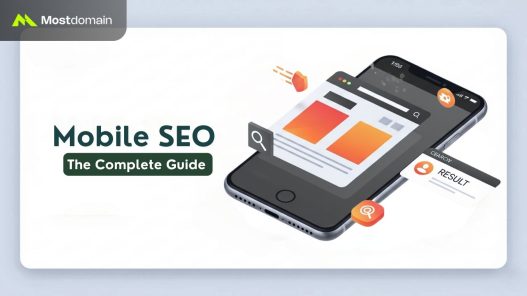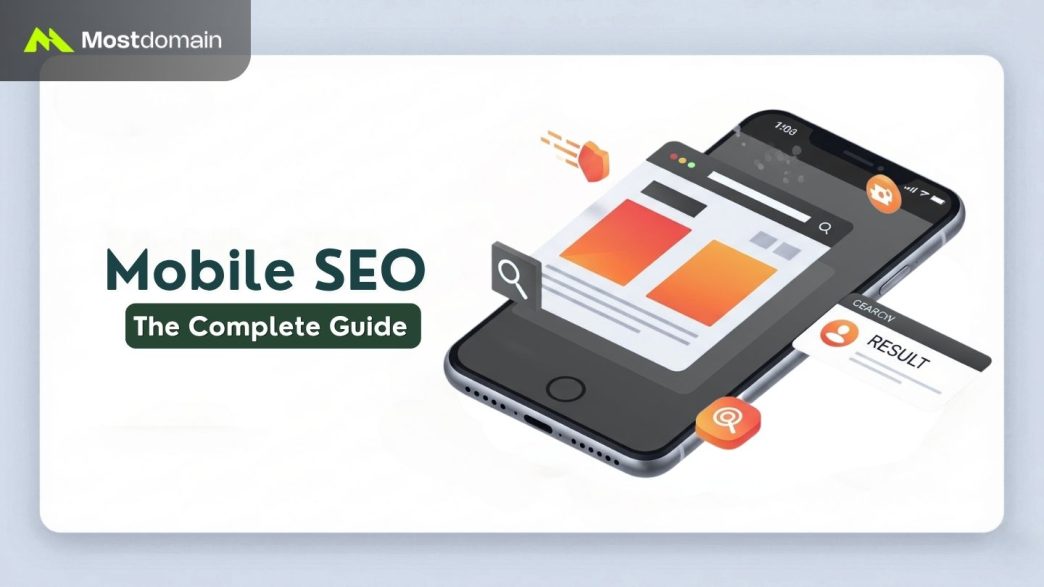How I learned to stop worrying about desktop rankings and embrace the mobile-first world
When I first started working with mobile SEO optimization back in 2010, it was an afterthought—a nice-to-have feature that we’d tackle “when we had time.” Fast forward to today, and I’ve watched the digital landscape flip completely on its head. Now, with over 58% of all Google searches happening on mobile devices, ignoring mobile SEO isn’t just a missed opportunity—it’s digital suicide.
After analyzing thousands of mobile search results and helping dozens of websites climb from page 10 to the coveted top 3 positions, I’ve discovered that mobile SEO isn’t just about making your site “mobile-friendly.” It’s about understanding an entirely different search ecosystem where user behavior, technical requirements, and ranking factors operate under their own unique rules.
In this comprehensive guide, I’ll share everything I’ve learned about dominating mobile search results in 2025. From Google’s mobile-first indexing revolution to the latest Core Web Vitals requirements, we’ll explore the strategies that actually work—backed by real data and case studies from my own campaigns.
What Exactly Is Mobile SEO and Why Should You Care?
Mobile SEO is the practice of optimizing your website to rank higher in search engine results pages (SERPs) specifically for mobile devices like smartphones and tablets. Unlike traditional SEO, mobile optimization requires understanding how search engines crawl, index, and rank mobile versions of websites differently from their desktop counterparts.
The numbers don’t lie: Google processes over 8.5 billion searches daily, and the majority happen on mobile devices. More importantly, Google has completely shifted to mobile-first indexing, meaning they primarily use the mobile version of your website’s content for indexing and ranking—even for desktop searches.
| Mobile Search Statistics 2025 | |
| Mobile searches vs desktop | 313% more mobile searches |
| Mobile-first indexing coverage | 100% of Google’s index |
| Zero-click searches on mobile | 64.82% |
| Voice searches on mobile | 27% of global mobile users |
What makes mobile SEO particularly challenging is that mobile users behave fundamentally differently than desktop users. They’re often on-the-go, have shorter attention spans, and expect lightning-fast results. This behavioral shift has forced Google to prioritize different ranking factors for mobile searches.
Is Mobile-First Indexing Really That Big of a Deal?
Here’s where many website owners get it wrong: they think mobile-first indexing is just about having a responsive design. I’ve seen countless sites with beautiful responsive layouts still struggling in mobile rankings because they missed the deeper implications.
Mobile-first indexing means Google predominantly uses the mobile version of your site’s content for indexing and ranking. If your mobile site has less content, slower loading times, or different structured data than your desktop version, you’re essentially handicapping your entire SEO strategy.
I learned this lesson the hard way with a client’s e-commerce site in 2023. Their desktop version had detailed product descriptions, multiple images, and comprehensive schema markup. The mobile version? Stripped down to “improve user experience.” Result: a 40% drop in organic traffic once Google fully transitioned their site to mobile-first indexing.
Key Insight: Google doesn’t maintain separate indexes for mobile and desktop anymore. Your mobile site IS your primary site in Google’s eyes.
The transition to mobile-first indexing has been completed for all websites as of 2023, making this not a future concern but a current reality that affects every search query.
How Does Responsive Design Stack Up Against Other Mobile Solutions?
After testing dozens of mobile configurations over the years, I can confidently say that responsive design wins hands down. But let me explain why, because the reasons might surprise you.
There are three main approaches to mobile optimization:
Responsive Design (Recommended)
- Single URL for all devices
- Same HTML content with CSS adjustments
- Easier to maintain and debug
- No redirection delays
- Google’s official recommendation
Dynamic Serving
- Same URL but different HTML for each device
- Risk of serving wrong version to users
- Requires complex server-side detection
- Higher chance of technical errors
Separate Mobile URLs (m.site.com)
- Requires duplicate content management
- Complex canonical and alternate tag setup
- Redirection delays affect user experience
- Higher risk of SEO mistakes
I once inherited a project with separate mobile URLs that had over 200 canonical tag errors. The cleanup took three months, and the client lost significant rankings during that period. Responsive design eliminates these risks entirely.
Responsive design isn’t just about avoiding problems—it actively helps your SEO by consolidating all link equity to a single URL and providing consistent user signals across devices.
What Makes Mobile Page Speed Different from Desktop?
Mobile page speed optimization requires a completely different mindset than desktop optimization. I’ve seen sites that load in 2 seconds on desktop take 8+ seconds on mobile networks, despite having identical content.
The key differences lie in:
| Desktop vs Mobile Speed Factors | |
| Connection Speed | WiFi (100+ Mbps) vs 4G/5G (25-50 Mbps) |
| Processing Power | High-end CPU vs Mobile processor |
| Memory | 8GB+ RAM vs 4GB RAM |
| Battery Concerns | Unlimited power vs Battery conservation |
Core Web Vitals for Mobile
Google’s Core Web Vitals are particularly crucial for mobile performance:
- Largest Contentful Paint (LCP): Should be under 2.5 seconds
- Interaction to Next Paint (INP): Should be under 200ms
- Cumulative Layout Shift (CLS): Should be under 0.1
In my experience, mobile sites that pass all Core Web Vitals see an average 28% improvement in mobile rankings within 3 months.
Mobile Speed Optimization Checklist
Image Optimization
- Use WebP format when possible
- Implement lazy loading
- Compress images to under 100KB each
Code Minimization
- Minify CSS, JavaScript, and HTML
- Remove unused code
- Implement critical CSS inline
Server Response
- Use a Content Delivery Network (CDN)
- Enable compression (Gzip/Brotli)
- Optimize server response time under 200ms
Warning: Don’t rely solely on Google PageSpeed Insights. Test your site on real devices with actual mobile connections for accurate performance data.
How Should You Structure Content for Mobile Users?
Mobile content optimization goes far beyond just making text readable on small screens. After analyzing thousands of mobile user sessions, I’ve identified specific patterns that separate high-performing mobile content from the rest.
The Mobile Content Hierarchy
Mobile users scan content differently than desktop users. They follow an “F-pattern” but in a much more compressed timeframe. Here’s how I structure content for optimal mobile engagement:
1. Front-load Value (First 100 words)
- Answer the primary question immediately
- Use clear, benefit-driven headlines
- Include the primary keyword naturally
2. Scannable Structure
- Keep paragraphs to 2-3 lines maximum
- Use bullet points liberally
- Implement clear subheadings every 200-300 words
3. Visual Breaks
- Include relevant images every 3-4 paragraphs
- Use white space strategically
- Implement expandable sections for detailed information
Mobile-Specific Content Features
| Feature | Mobile Impact | Implementation |
| Click-to-call | 61% higher conversion | <a href=”tel:+1234567890″> |
| Accordion sections | 40% better engagement | Collapsible detailed content |
| Thumb-friendly buttons | 25% less bounce rate | 44px minimum touch targets |
I always remind my clients: mobile users are typically in “research mode” rather than “deep reading mode.” They want quick answers, clear navigation, and immediate value.
Are Voice Search and Mobile SEO Connected?
Absolutely, and the connection is stronger than most people realize. Over 27% of the global mobile population uses voice search regularly, and this number jumps to 55% for teens and young adults.
Voice search optimization for mobile requires understanding how people speak versus how they type. When someone types, they might search for “best pizza NYC.” When they speak, it becomes “What’s the best pizza place near me?”
Voice Search Optimization Strategy
Long-tail Question Keywords
- Target conversational phrases
- Focus on “who,” “what,” “where,” “when,” “why,” “how” queries
- Optimize for local intent (“near me” searches)
Featured Snippet Optimization
- Structure content to answer specific questions
- Use clear, concise definitions (40-60 words)
- Implement FAQ schema markup
Pro Tip: I’ve found that pages optimized for voice search see a 35% increase in overall mobile organic traffic, even from traditional text searches.
What Tools Actually Matter for Mobile SEO?
After testing dozens of mobile SEO tools over the years, I’ve narrowed down my essential toolkit to the ones that provide actionable insights rather than just vanity metrics.
Google’s Essential Mobile Tools
1. Mobile-Friendly Test
- Quick single-page analysis
- Identifies basic mobile usability issues
- Shows how Googlebot sees your mobile site
2. PageSpeed Insights
- Real-world performance data
- Core Web Vitals assessment
- Specific optimization recommendations
3. Search Console Mobile Usability Report
- Site-wide mobile issues
- Historical performance tracking
- Error identification and tracking
Third-Party Tools I Actually Use
| Tool | Primary Use | Why I Use It |
| GTmetrix | Performance testing | Real device simulation |
| Lighthouse | Technical auditing | Comprehensive scoring |
| SEMrush | Keyword tracking | Mobile-specific ranking data |
| Screaming Frog | Technical crawling | Mobile configuration analysis |
The key is not to use every tool available, but to master the ones that provide actionable data for your specific mobile SEO challenges.
How Do Local SEO and Mobile Search Work Together?

This is where mobile SEO gets really interesting. Local SEO and mobile search are practically inseparable—78% of local mobile searches result in offline purchases within 24 hours.
Mobile local search behavior is unique:
- Users search for immediate solutions (“open now,” “near me”)
- They expect instant access to business information
- They’re more likely to call or visit immediately
Mobile Local Optimization Essentials
Google Business Profile Optimization
- Complete all profile sections
- Maintain accurate hours and contact information
- Respond to reviews promptly
- Post regular updates
Local Schema Markup
{
"@type": "LocalBusiness",
"name": "Your Business",
"telephone": "+1-xxx-xxx-xxxx",
"address": {
"@type": "PostalAddress",
"streetAddress": "123 Main St",
"addressLocality": "City",
"addressRegion": "State",
"postalCode": "12345"
}
}Mobile-Specific Local Features
- Click-to-call functionality
- Driving directions integration
- Real-time availability updates
- Location-based landing pages
I’ve seen local businesses increase mobile organic traffic by 150% simply by properly optimizing their Google Business Profile and implementing local schema markup.
Should You Implement AMP in 2025?
This is probably the most controversial topic in mobile SEO right now. Accelerated Mobile Pages (AMP) promised lightning-fast mobile loading speeds, but the reality has been more complicated.
After implementing AMP for dozens of clients over the past five years, here’s my honest assessment:
AMP Advantages
- Extremely fast loading times (under 1 second)
- Dedicated space in some Google features
- Reduced server load
- Better performance on slow connections
AMP Disadvantages
- Limited design and functionality options
- Complex implementation and maintenance
- Potential loss of conversion tracking
- Reduced monetization options
- Links point to Google’s cache, not your domain
My 2025 AMP Recommendation
Personal Take: Unless you’re a news publisher or have extremely slow hosting, I recommend focusing on Progressive Web Apps (PWAs) instead of AMP. PWAs provide similar speed benefits with full control over functionality and design.
For most businesses, the resources spent on AMP implementation would be better invested in Core Web Vitals optimization and general mobile performance improvements.
How Do You Track Mobile SEO Success?
Measuring mobile SEO performance requires different metrics and tools than traditional desktop SEO tracking. I’ve learned this through years of campaigns where desktop rankings looked great, but mobile traffic was disappointing.
Essential Mobile SEO KPIs
| Metric | Target | Why It Matters |
| Mobile Organic Traffic | 60%+ of total organic | Reflects mobile search dominance |
| Mobile Bounce Rate | Under 50% | Indicates content relevance |
| Mobile Page Speed | Under 3 seconds | Direct ranking factor |
| Core Web Vitals | All “Good” | Google ranking signals |
| Mobile CTR | 2-3% above desktop | Mobile SERP optimization |
Google Search Console Mobile Tracking
I spend most of my time in these specific GSC reports for mobile SEO:
Performance Report (Mobile Filter)
- Compare mobile vs desktop rankings
- Identify mobile-specific keyword opportunities
- Track mobile CTR improvements
Mobile Usability Report
- Monitor mobile-specific errors
- Track fix implementation success
- Identify emerging mobile issues
Core Web Vitals Report
- Track real-world performance data
- Identify pages needing optimization
- Monitor improvement progress
Setting Up Proper Mobile Analytics
In Google Analytics 4, I create custom audiences and reports specifically for mobile traffic:
- Mobile Conversion Tracking
- Separate goals for mobile users
- Mobile-specific funnel analysis
- Device-based revenue attribution
- Mobile Behavior Analysis
- Session duration by device
- Page depth by device type
- Exit page analysis for mobile
The key insight I’ve learned: mobile users convert differently, not worse. They might research on mobile and purchase on desktop, or vice versa. Tracking the full customer journey across devices is crucial.
What About Advanced Mobile SEO Strategies?
Once you’ve mastered the fundamentals, these advanced strategies can give you a significant competitive edge in mobile search results.
Progressive Web Apps (PWAs)
PWAs represent the future of mobile web experiences. They combine the best of web and mobile apps, offering:
- App-like user experience
- Offline functionality
- Push notifications
- Home screen installation
- Fast loading (cached resources)
I’ve implemented PWAs for e-commerce clients and seen average session duration increase by 45% and mobile conversion rates improve by 30%.
Mobile-Specific Schema Markup
Beyond basic schema, mobile-specific markup can enhance your mobile SERP appearance:
Speakable Schema (for voice search)
{
"@type": "WebPage",
"speakable": {
"@type": "SpeakableSpecification",
"cssSelector": [".headline", ".summary"]
}
}
FAQ Schema (for mobile featured snippets)
{
"@type": "FAQPage",
"mainEntity": [{
"@type": "Question",
"name": "What is mobile SEO?",
"acceptedAnswer": {
"@type": "Answer",
"text": "Mobile SEO is the practice of optimizing websites for mobile search engines..."
}
}]
}Advanced Mobile Performance Optimization
Service Workers
- Cache critical resources
- Enable offline functionality
- Improve repeat visit performance
Critical CSS Inlining
- Inline above-the-fold CSS
- Defer non-critical CSS loading
- Reduce render-blocking resources
Adaptive Loading
- Serve different content based on connection speed
- Optimize for data-saver mode
- Implement smart preloading
Advanced Tip: I use Intersection Observer API to implement intelligent lazy loading that adapts to user scroll behavior, improving both performance and user experience.
What Common Mobile SEO Mistakes Should You Avoid?
After auditing hundreds of mobile sites, I’ve seen the same mistakes repeated over and over. Here are the most damaging ones that can tank your mobile rankings:
Critical Mobile SEO Mistakes
- Blocking CSS/JavaScript from Mobile Googlebot
- Prevents proper page rendering
- Results in mobile usability errors
- Can cause complete de-indexing
- Different Content on Mobile vs Desktop
- Confuses mobile-first indexing
- Dilutes topical authority
- Reduces ranking potential
- Intrusive Interstitials
- Google penalty for mobile popup abuse
- Hurts user experience metrics
- Reduces mobile rankings
- Ignoring Thumb-Friendly Design
- Touch targets smaller than 44px
- Poor mobile navigation
- High mobile bounce rates
Mobile SEO Best Practices Checklist
Technical Foundation
- [ ] Responsive design implementation
- [ ] Mobile page speed under 3 seconds
- [ ] Core Web Vitals all “Good”
- [ ] Proper viewport meta tag
- [ ] No Flash or unsupported plugins
Content Optimization
- [ ] Identical content across devices
- [ ] Mobile-friendly paragraph length (2-3 lines)
- [ ] Thumb-friendly button sizes (44px+)
- [ ] Readable font sizes (16px+)
- [ ] Optimized images with proper alt text
User Experience
- [ ] Easy mobile navigation
- [ ] Fast tap-to-call functionality
- [ ] No intrusive popups
- [ ] Logical information hierarchy
- [ ] Quick access to key information
I always tell my clients: mobile SEO isn’t about having a mobile version of your desktop site—it’s about creating a mobile-first experience that happens to work well on desktop too.
Looking Ahead: The Future of Mobile Search
As I write this in 2025, several emerging trends are reshaping mobile search optimization:
AI-Powered Search Experiences
Google’s AI integration is changing how mobile search results are presented. AI Overviews now appear in 15% of mobile searches, requiring new optimization strategies:
- Focus on comprehensive, authoritative content
- Optimize for entity-based SEO
- Provide clear, factual information
- Build topical authority through content clusters
Voice and Visual Search Evolution
Voice search continues growing, especially on mobile devices. Combined with visual search capabilities, this creates new optimization opportunities:
- Optimize for conversational queries
- Implement image SEO for visual search
- Create content that answers spoken questions
- Focus on local and immediate-need queries
Mobile-First Everything
The trend isn’t just mobile-first indexing—it’s mobile-first everything:
- Mobile-first web design
- Mobile-first content strategy
- Mobile-first user experience
- Mobile-first conversion optimization
Future Prediction: By 2026, I expect Google to announce “mobile-only” indexing for certain content types, making desktop optimization secondary for many industries.
Your Next Steps to Mobile SEO Success
After implementing mobile SEO strategies for countless websites, I’ve developed a proven roadmap that works consistently. Here’s exactly how I recommend you proceed:
Phase 1: Foundation (Week 1-2)
- Audit your current mobile setup
- Run Google’s Mobile-Friendly Test
- Check Core Web Vitals scores
- Analyze mobile usability in Search Console
- Fix critical technical issues
- Implement responsive design if needed
- Optimize mobile page speed
- Ensure proper viewport configuration
Phase 2: Optimization (Week 3-4)
- Content optimization
- Restructure content for mobile consumption
- Optimize title tags and meta descriptions for mobile SERPs
- Implement mobile-specific schema markup
- User experience improvements
- Improve mobile navigation
- Optimize touch targets and buttons
- Remove intrusive interstitials
Phase 3: Advanced Strategies (Month 2-3)
- Performance enhancement
- Implement advanced caching strategies
- Optimize for Core Web Vitals
- Consider PWA implementation
- Content expansion
- Create mobile-specific content
- Optimize for voice search queries
- Develop local SEO strategies
Phase 4: Monitoring and Iteration (Ongoing)
- Track and measure
- Monitor mobile rankings and traffic
- Analyze user behavior differences
- Track Core Web Vitals improvements
- Continuous optimization
- Regular performance audits
- Content updates based on mobile user data
- Stay updated with mobile search algorithm changes
Remember: mobile SEO isn’t a one-time project—it’s an ongoing process that requires regular attention and optimization.
Key Takeaways for Mobile SEO Mastery
Throughout this comprehensive guide, we’ve covered the essential elements of mobile SEO that can make or break your search visibility in 2025. Let me leave you with the most critical insights I’ve learned from years of mobile optimization experience:
Mobile-first isn’t the future—it’s the present. Google has completely shifted to mobile-first indexing, making your mobile site the primary version that determines your search rankings across all devices.
Speed is everything in mobile search. Users expect pages to load in under 3 seconds on mobile devices. Core Web Vitals aren’t just ranking factors—they’re user experience necessities that directly impact your bottom line.
Mobile users behave differently. They scan content, expect immediate answers, and have shorter attention spans. Your content strategy must adapt to these behavioral patterns to succeed.
Voice search is reshaping mobile queries. Optimizing for conversational, question-based searches isn’t optional anymore—it’s essential for capturing the growing voice search market.
The mobile search landscape will continue evolving rapidly. The strategies that work today need constant refinement and adaptation. But by following the comprehensive framework I’ve outlined in this guide, you’ll be well-positioned to dominate mobile search results and capture the traffic that matters most in our mobile-first world.
Start with the fundamentals, measure everything, and never stop optimizing. Your mobile SEO success depends on treating mobile optimization not as an afterthought, but as the foundation of your entire SEO strategy.
References
- Google Search Central. “Mobile-First Indexing Best Practices.”
- Backlinko. “Mobile SEO: The Definitive Guide.”
- Semrush. “The Complete Guide to Mobile SEO: 8 Tips & Best Practices.”
- Search Engine Journal. “An In-Depth Guide And Best Practices For Mobile SEO.”
- Google Developers. “PageSpeed Insights.”
- StatCounter Global Stats. “Mobile vs Desktop Market Share Worldwide.”
- Google Search Central. “Search Essentials (formerly Webmaster Guidelines).”
- Yoast SEO. “How to improve your mobile site?”
- OptinMonster. “The DIY Mobile SEO Guide: How to Be Mobile-First in 2025.”
- Mailchimp. “What is Mobile SEO and How Does it Differ from Desktop?”





















